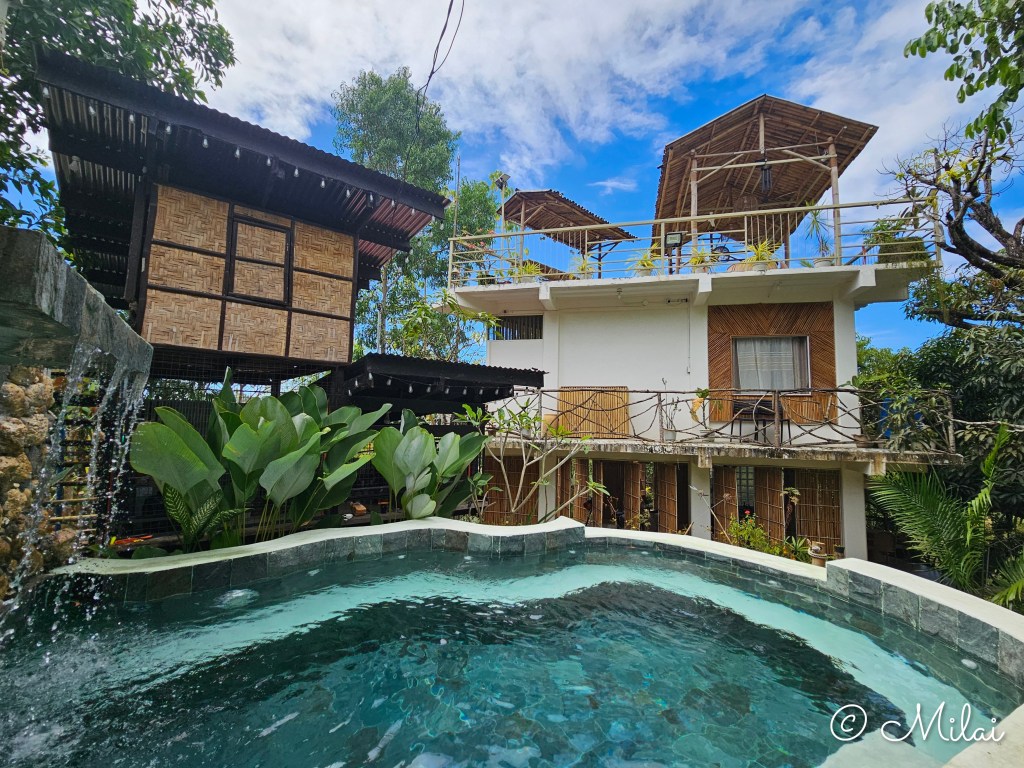
I’ve been seeing ads of Sialo on its official Instagram account and was curious about its Progressive Cebuano Cuisine and Local Luxury taglines, so I booked its Berano Grande, the 16-course summer tasting menu, last week and visited the place last Tuesday, the 25th.
Rate: Php 4,500+ per person, exclusive of drinks unless the drink is part of the menu
The Menu

This is Berano Grande, the 16-course Sialo Summer tasting menu. A staff explained the menu to me when I arrived. She said it tells the story of Chef Ron, the owner and chef’s, summer experiences.
Aside from the ads and its well-curated Instagram page, the menu was one of the reasons why I wanted to try Sialo, as most of the items are named uniquely and humorously. For example, “Kay Nangamote Man” is an expression used when someone gets a low grade in school.
Kinutil

The staff said that as an introduction to Cebuano cuisine, they prepared a drink made of local ingredients. I did not get the whole list but heard Biasong (a local citrus), Vino Kulafu, GSM (Ginebra San Miguel) Gin, and lemongrass.
I did not like it. It tasted weak and predominantly of lemongrass; I was hoping for a more citrusy and alcoholic flavor.
The Drinks List

Thankfully, I liked the two drinks I ordered.
First I had Sulirap. The menu had this as its description: Seryales, Rose Water, Biasong, and Rose Petals.

I like it. From the moment they served it to me, I could smell the roses, and the taste was well-melded, although the predominant flavor was still roses.
Once I finished my Sulirap, I ordered I Gugma U. This means “I love you” in Cebuano. They listed its ingredients as Fizzy Bubble and Homemade Citrus Syrup. It was good, but it tasted too fizzy.

Again, note how playful the drink names were. Sulirap means an eye-roll. And there was even an item named “Makabuhi’g Patay,” which meant raising someone from the dead. It must have been too strong a drink to have that effect.
Luto-Luto sa Ku’on
The Berano Grande experience starts big with this: an amuse bouche named Luto Luto sa Ku’on or bite-sized appetizers in mini clay pots sourced from the southern town of Sibonga, Cebu.

Chef Ron himself delivered this to my table and explained how, as a child, he would “cook” using these miniature clay pots. I smiled as he narrated his story, my mind drifting off to my childhood when I would do the same. I remember even cooking with edible leaves (camote tops) and selling them to our friends using play money.
I liked the entire set except the soup (the green liquid in the teenie weenie wooden bowl), which I found salty.



Gikamatis
Next, they served Gikamatis, a tribute to the kamatis (tomato) in the dish encased in gelatin on a bed of cheesy mixture. Relating this to summer, the staff shyly explained that during summer, boys usually get circumcised and the swelling during this period is called “gikamatis,” (becoming like a kamatis) owing to the reddish appearance of the penis.

I wasn’t impressed by this dish. It was so cheesy that it swallowed the essence of the tomato.
Merienda: Ca-pea-ccino + Pea-Tinduganay
Tinduganay, is a heritage legume similar to the mongo or mung bean. Sialo used tinduganay to give the usual merienda (snacks) a new spin via “Ca-pea-ccino + Pea-Tinduganay.” This duo is composed of a pea biscuit filled with tinduganay cream and puree coupled with “fake” ca-pea-ccino made of peas.

While I liked the filling, the biscuit was hard, and the fake ca-pea-ccino did not taste cappuccino-ish enough.
Kay Nangamote Man (Textures of Sweet Potato)
Of course, this is made of sweet potato (camote) on a bed of some sweet dip.

I liked these because the sweet potato chips are sliced so thinly and baked (?) to perfection, with perfect crispiness.

I asked the staff if these were really the colors of the sweet potato and was told they just colored it.
Tabanog: Fly Your Colors
I loved making and flying kites as a child, so I liked the presentation of this dish and was interested in its ingredients. Imagine my disappointment when I was told that while the red one was tomato paste and the yellow one was mango, the blue one was blue curacao. Like how is this Cebuano/Filipino?

At this point, I was feeling disappointed with my Sialo experience. I thought they focused so much on the presentation but failed to combine the flavors and textures. I mean, I wouldn’t mind if it did not cost so much, but it did, so I was expecting to be served good and not just visually arresting food filled with stories.
Note that this isn’t my first degustacion; my most notable were at the Michelin-starred Caelis in Barcelona and in Lima’s Central, the world’s top restaurant in 2023.
A Walk in the Woods: Textures of Mushrooms
This is perhaps the highlight of my dining experience in Sialo primarily because it acquainted me to Takyong, a bush snail endemic in Borbon town in northern Cebu. Aside from the excellent presentation, the snail was cooked to perfection.

I wasn’t a fan of the fake mushrooms, though, like the mushroom-shaped chocolates (?). The shift in flavors was jarring because, from the perfectly cooked snail and the salty (but again fake) mushroom-shaped chicken dish, I was then asked to eat something sticky-sweet.

Ang Buntog nga Gibantog
This was a well-presented dish made of quail.

I did not like it. The quail meat was tough, and the egg puff was too oily. The sauce was okay, though.
Flores De Mayo
This is another well-presented but underwhelming dish.

The beetroot was shaped like a rose and wrapped in froth. I giggled when I scooped a taste because I remembered someone’s recent comment when he knew I booked a dinner at Sialo. “You know how you can make a dish fancy? Add bubbles.” Ha ha!

The accompanying dish was ceviche. It was good, but lacked a more vinegar-y taste. The basket was also not crunchy.

Pansat, Pansit,Paksit
This is a wild prawn wrapped in fresh pancit miki before being deep-fried in clarified butter, complemented by coconut chutney, chili jam, white wine emulsion, and shrimp curry sauce.

The prawn was overcooked, and the pancit was hard. But I liked the coconut chutney and the shrimp curry sauce.
Asa Kasagaran Masaag ang Kasag

I liked this dish because I liked crab, though the crab patty could have been more tender.

Ang Kinabuhi Mura’g Beach (Life’s a Beach)

Again, the presentation was good and I liked the mussels, but the batter was over-fried.
And no, that’s not caviar. That’s fake caviar, according to the staff.

Summer Campfire
I already figured out that this would be grilled items, so I looked forward to having this dish, especially since this is the finale among the main dishes. It was served fancily, too, with a glass dome covering a ball of edible charcoal and ash.


There were 2 skewers. One was made of chicken and the other of pork. Both were a disappointment. The chicken was overcooked, and the pork lacked flavor.


Ice Drop: Binignit Nga Di Init
Binignit is the Visayan’s answer to Ginataang Halo-Halo. It is a fusion of sticky rice, fruits, tubers, and tapioca pearls cooked in coconut milk. It is usually served hot, but as the name suggests, Sialo froze it and made it an ice drop (popsicle), a popular summer treat in the country.

I love Binignit and prefer my Binignit cold, so I love this.
Karambola sa Iskrambol
Iskrambol (ice scramble) is another popular summer treat in the country. It’s a dessert made from shaved ice with fruits, evaporated milk, and sugar.

Sialo elevated this usual summer street fare by using local wild fruits. What went into this dessert is well thought-of because the flavors were harmonious. Some of the fruits were sour and the others sweet, but the right amount of milk and ice made the fusion a gustatory sensation.
Yes, by now one can tell I have a sweet tooth, and desserts are my weakness. Te he.
Ang Kanta sa Sampaguita
Sampaguita (Jasmine) is our national flower. Their Instagram description says this is “a floral dessert that is sure to make you sing praises.”

This is my favorite among the 4 desserts. As I love the scent of jasmine, I could tell its scent from the moment they put the plate on my table. It tasted so good!
Ang Tanaman sa Ting-init or Summer Garden
This takes inspiration from the Palawan Cherry Blossom Tree, which holds many chocolatey surprises.
The photo I saw on their Instagram had pink cotton candy, but mine was served blue, so I don’t know what inspired this.

Unfortunately, the staff took so long in explaining this dish that the cotton candy melted and I was left with this ruined tree. Phooey.

As for the chocolates, I did not like it. It’s too bad that this was my finale – dessert as while I was looking forward to the presentation – which did not disappoint – the ruined aesthetics and the underwhelming chocolates left a bad taste on my mouth.
Sungkaan
Sungka is a Philippine mancala game.

The staff said this was some sort of thank you. It featured Masi, a dish of glutinuous rice balls with a munggo (mung bean) filling. (The typical Masi uses peanut and muscovado filling.)
I did not like it. the mung filling was gooey and tasted too sweet, with none of the mung taste typical in mung bean desserts. The peanut brittle was good, though.
The Service
Everyone had been attentive without being intrusive throughout my meal. The headwaitress knew her craft, but the rest need more practice. They knew the spiel, but when probed, they could not converse spontaneously and confidently.
My Overall Experience
All in all, with the meal, drinks, and tip, I spent over Php 8,000 (about US$ 140) but I felt it was not worth it. I’d rate my experience a 3/5.
I acknowledge the good intention to promote and elevate local food, but the execution was just underwhelming. For example, instead of serving fake (sweet, chocolatey) mushrooms, why not use real mushrooms for A Walk in the Woods considering that there are many mushroom varieties in the country? It makes the experience more real as it’s part of the main course and mushrooms are known for their earthy and meaty and definitely not chocolatey flavor. Or use different varieties of colorful and natural sweet potato for Kay Nangamote Man instead of coloring them? Central in Lima served us different varieties of potatoes and corn and none was colored or fake.

Sialo is located in 7A President Laurel Street, Cebu City. Visit their website to reserve.





Leave a comment